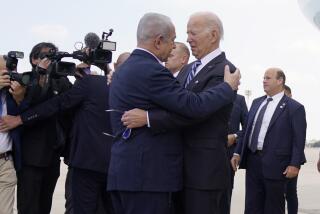Reagan Trims Waiting Time on ‘Star Wars’
- Share via
WASHINGTON — On the eve of Secretary of State George P. Shultz’s visit to Moscow, President Reagan has decided to reduce from 10 years to eight the period during which he would be willing to refrain from deploying anti-missile space defenses, U.S. officials said Friday.
The shift, though small, could make a new agreement on strategic nuclear arms more difficult to reach. However, it is unlikely to affect the negotiations on intermediate-range missiles that are expected to produce agreement--and possibly a new U.S.-Soviet summit--later this year.
Reagan’s new position, a retreat from his offer at the U.S.-Soviet summit meeting in Iceland, was proposed by Defense Secretary Caspar W. Weinberger on grounds that the Strategic Defense Initiative, Reagan’s proposed space-based missile defense system, is proceeding faster than expected, with deployment possible in 1994 instead of 1996.
Reykjavik Stalemate
The State Department had urged that the 10-year offer be reaffirmed.
Shultz will be visiting Moscow to explore recent indications of an increased willingness by the Soviets to compromise on arms control issues since the Reykjavik summit ended in a stalemate last October. In February, Soviet leader Mikhail S. Gorbachev proposed that all nuclear missiles in Europe be eliminated.
In addition to taking a stronger line on delaying deployment of the SDI system, popularly known as “Star Wars,” Shultz will tell the Soviets that the President’s position has not changed on the most vital point of the issue. Reagan insists that after the period of non-deployment, each side will be free to go ahead with missile defenses, thereby abrogating the 1972 Anti-Ballistic Missile Treaty.
Soviet Position
The Soviets have always maintained that they will not make any agreement that would kill the ABM treaty and will not reduce offensive nuclear arms without some guarantee against new missile defenses being built. An obvious way to overcome a U.S. missile defense is with a larger offensive arsenal, they argue.
The shortening of the time period for non-deployment of SDI suggests that the United States is moving further from the Soviet position rather than closer to it. Moscow may conclude that the Administration is no longer working toward a new strategic arms agreement, some officials believe.
A senior official rejected this conclusion, however, noting that Shultz will not repeat Reagan’s call in Reykjavik to eliminate all offensive ballistic missiles in 10 years, while at the same time promising not to withdraw from the ABM treaty for 10 years.
Negotiating Ploy?
The Soviets had rejected the ballistic missile proposal because their nuclear offense consists overwhelmingly of missiles, with relatively few bombers and cruise missiles. This would leave the United States, with its much larger bomber force, with a far superior nuclear force.
Another official suggested that the shortened time period is a U.S. negotiating ploy, balancing a Soviet retreat from Reykjavik in the field of strategic offensive weapons. In Iceland, Gorbachev accepted in principle the need for ceilings on different types of weapons, but Soviet negotiations since then have denied that the understanding is still binding.
More to Read
Sign up for Essential California
The most important California stories and recommendations in your inbox every morning.
You may occasionally receive promotional content from the Los Angeles Times.










